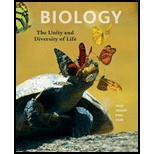
Concept explainers
Most commonly, individuals of a population show a _______ distribution within their habitat.
- a. clumped
- b. random
- c. nearly uniform
- d. none of the above
Concept introduction: A population is a group of interbreed organisms of same species that lives in same area. Population distribution is an arrangement of population in a particular area according to its conditions and requirements of the society. It also describes the location of individuals relative to one another. There are three types of population distribution, namely clumped, nearly uniform, and random.
Answer to Problem 1SQ
Correct answer: Most commonly, individuals of a population show a clumped distribution within their habitat. Hence, the correct answer is option a.
Explanation of Solution
Reason for the correct statement:
Distribution is a whole number of people or inhabitants in a specified region. Clumped distribution is an uneven distribution of population in the environment. Social interactions between the individuals can also cause the distribution to be clumped.
Option c. is given as “clumped”. In this distribution, the distance between the individuals is minimized. Therefore, the organisms do not move and the offspring are close to their parents. Hence, it shows the clumped dispersion. This limited dispersal ability increases the likelihood of a clumped distribution. Hence, option c. is the correct answer.
Reasons for the incorrect statements:
Option b. is given as “random”. Populations are randomly distributed only if the resources are uniformly available. Random distribution occurs from the nature of relationships between the individuals. Hence, option b. is incorrect.
Option c. given as “nearly uniform”. Nearly uniform distribution occurs only if there is a competition for limited resources with the individuals. Hence, option c. is incorrect.
Option d. given as “none of the above”. Most of the individuals show the clumped distribution within their habitat. Hence, option d. is incorrect.
Hence, options b., c., and d. are incorrect.
Clumped distribution of population occurs within the same habitat. The uneven distribution of resources causes the population to clump together.
Want to see more full solutions like this?
Chapter 44 Solutions
Biology: The Unity and Diversity of Life (MindTap Course List)
Additional Science Textbook Solutions
Laboratory Manual For Human Anatomy & Physiology
Chemistry: An Introduction to General, Organic, and Biological Chemistry (13th Edition)
Campbell Essential Biology (7th Edition)
Genetics: From Genes to Genomes
HUMAN ANATOMY
Organic Chemistry
- can you help? I think its B but not surearrow_forwardSkip to main content close Homework Help is Here – Start Your Trial Now! arrow_forward search SEARCH ASK Human Anatomy & Physiology (11th Edition)BUY Human Anatomy & Physiology (11th Edition) 11th Edition ISBN: 9780134580999 Author: Elaine N. Marieb, Katja N. Hoehn Publisher: PEARSON 1 The Human Body: An Orientation expand_moreChapter 1 : The Human Body: An Orientation Chapter Questions expand_moreSection: Chapter Questions Problem 1RQ: The correct sequence of levels forming the structural hierarchy is A. (a) organ, organ system,... format_list_bulletedProblem 1RQ: The correct sequence of levels forming the structural hierarchy is A. (a) organ, organ system,... See similar textbooks Bartleby Related Questions Icon Related questions Bartleby Expand Icon bartleby Concept explainers bartleby Question Draw a replication bubble with two replication forks.blue lines are DNA single strands and red lines are RNA single strands.indicate all 3' and 5’ ends on all DNA single…arrow_forwardProvide an answerarrow_forward
- Question 4 1 pts Which of the following would be most helpful for demonstrating alternative splicing for a new organism? ○ its proteome and its transcriptome only its transcriptome only its genome its proteome and its genomearrow_forwardIf the metabolic scenario stated with 100 mM of a sucrose solution, how much ATP would be made then during fermentation?arrow_forwardWhat is agricuarrow_forward
- When using the concept of "a calorie in is equal to a calorie out" how important is the quality of the calories?arrow_forwardWhat did the Cre-lox system used in the Kikuchi et al. 2010 heart regeneration experiment allow researchers to investigate? What was the purpose of the cmlc2 promoter? What is CreER and why was it used in this experiment? If constitutively active Cre was driven by the cmlc2 promoter, rather than an inducible CreER system, what color would you expect new cardiomyocytes in the regenerated area to be no matter what? Why?arrow_forwardWhat kind of organ size regulation is occurring when you graft multiple organs into a mouse and the graft weight stays the same?arrow_forward
- What is the concept "calories consumed must equal calories burned" in regrads to nutrition?arrow_forwardYou intend to insert patched dominant negative DNA into the left half of the neural tube of a chick. 1) Which side of the neural tube would you put the positive electrode to ensure that the DNA ends up on the left side? 2) What would be the internal (within the embryo) control for this experiment? 3) How can you be sure that the electroporation method itself is not impacting the embryo? 4) What would you do to ensure that the electroporation is working? How can you tell?arrow_forwardDescribe a method to document the diffusion path and gradient of Sonic Hedgehog through the chicken embryo. If modifying the protein, what is one thing you have to consider in regards to maintaining the protein’s function?arrow_forward

 Biology Today and Tomorrow without Physiology (Mi...BiologyISBN:9781305117396Author:Cecie Starr, Christine Evers, Lisa StarrPublisher:Cengage Learning
Biology Today and Tomorrow without Physiology (Mi...BiologyISBN:9781305117396Author:Cecie Starr, Christine Evers, Lisa StarrPublisher:Cengage Learning Biology: The Unity and Diversity of Life (MindTap...BiologyISBN:9781305073951Author:Cecie Starr, Ralph Taggart, Christine Evers, Lisa StarrPublisher:Cengage Learning
Biology: The Unity and Diversity of Life (MindTap...BiologyISBN:9781305073951Author:Cecie Starr, Ralph Taggart, Christine Evers, Lisa StarrPublisher:Cengage Learning Biology: The Dynamic Science (MindTap Course List)BiologyISBN:9781305389892Author:Peter J. Russell, Paul E. Hertz, Beverly McMillanPublisher:Cengage Learning
Biology: The Dynamic Science (MindTap Course List)BiologyISBN:9781305389892Author:Peter J. Russell, Paul E. Hertz, Beverly McMillanPublisher:Cengage Learning Biology (MindTap Course List)BiologyISBN:9781337392938Author:Eldra Solomon, Charles Martin, Diana W. Martin, Linda R. BergPublisher:Cengage Learning
Biology (MindTap Course List)BiologyISBN:9781337392938Author:Eldra Solomon, Charles Martin, Diana W. Martin, Linda R. BergPublisher:Cengage Learning





